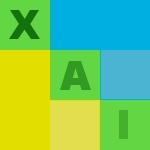 |
|
|
|
|
- about
- documentation
- screenshots
- download
- faq
- hacking
- links
|
|
|
|
 |
|
|
|
|
F.A.Q.
1. General
1.1 What is it good for?
The XAI Environment is an extensible tool which allows prototyping of image
and video analysis algorithms. The algorithms are divided into functional
blocks such as Binarization or CannyFilter and their inputs and outputs can be
connected in order to provide data flow between proper steps of the algorithm.
XAI comes with GUI, execution engine and default set of blocks, mostly
wrappers over OpenCV library functions.
1.2 Is it usable yet?
Yes, XAI can be already used - although one should remember that this is still
alpha software. Several bugs still exist, especially at the GUI layer.
1.3 Is this project interesting?
Yep.
2. Installation and configuration
2.1 What are the requirements for XAI?
For a minimal configuration - that is without GUI and OpenCV the requirements
are very minimal and any Linux system should satisfy them. However if You want
some additional functionality such as OpenCV methods or color output using SDL
library You should try to compile on Your system and the ./configure script
should complain if some of the dependencies are not satisfied.
3. Using XAI
3.1 Can XAI be used without the GUI?
Yes. XAI can be even compiled without GUI - e.g. on systems without X Windows.
Once You have an algorithm specification ready (proper XML file) or You can
write XML by hand, You can run XAI from command line by adding -n (or--no-gui)
option to command line parameters.
4. Using the GUI
4.1 How do I connect two blocks?
Currently, two ways exist to connect two blocks. The simplest one is to select
Edit/Connect... (or Ctrl-C) and then click on the canvas. An arrow will showup
which can be dragged to proper input and output. Another way is to select
Edit/Connect by Id... and then type in the popup window ids of blocks with
numbers of input and output. Due to bugs in the GUI sometimes it is the only
way to properly connect two blocks (e.g. when one output is connected to
multiple inputs).
4.2 How do I change block properties?
First select a block and then select Edit/Edit block properties (or click
Ctrl-E) and a custom pop-up window will show up with which You can edit all
internal properties of the block. In general it is possible to change the
properties of blocks without stopping or pausing the algorithm, however it
depends on the implementation of the block, i.e. some properties can be read
only once during start of the algorithm and not validated afterwards.
4.3 Why does Pause not work?
It's a temporary situation - check here again soon.
4.4 Can I run the algorithm on a picture instead of video?
Of course. When pressing start a pop-up shows up and You have to select
one-shot mode. The algorithm will run once and stop and the output - if any -
will be shown.
5. Default blocks
5.1 What default blocks are available?
The list of available default blocks is available in documentation. Basically
they cover a subset of OpenCV functions plus some additional functionality.
|
